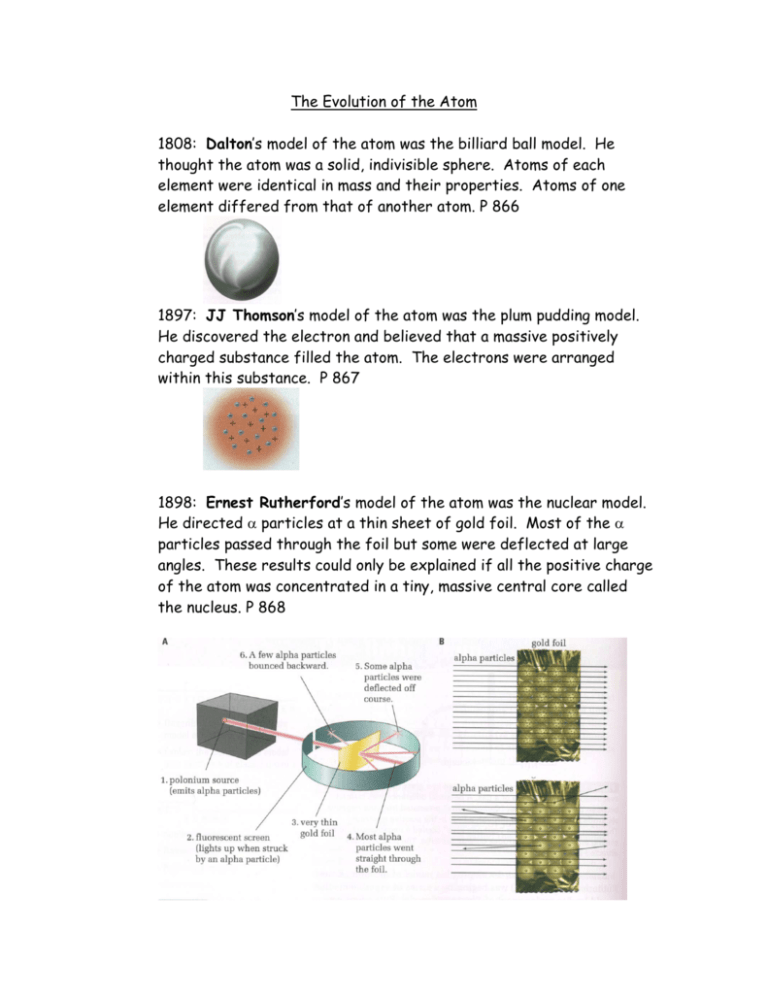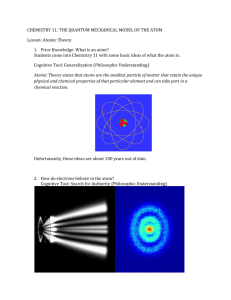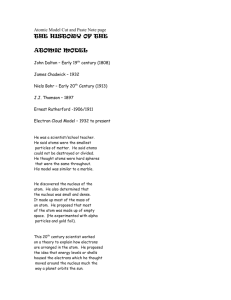The Evolution of the Atom 1808: Dalton's model of the atom was the
advertisement

The Evolution of the Atom 1808: Dalton’s model of the atom was the billiard ball model. He thought the atom was a solid, indivisible sphere. Atoms of each element were identical in mass and their properties. Atoms of one element differed from that of another atom. P 866 1897: JJ Thomson’s model of the atom was the plum pudding model. He discovered the electron and believed that a massive positively charged substance filled the atom. The electrons were arranged within this substance. P 867 1898: Ernest Rutherford’s model of the atom was the nuclear model. He directed α particles at a thin sheet of gold foil. Most of the α particles passed through the foil but some were deflected at large angles. These results could only be explained if all the positive charge of the atom was concentrated in a tiny, massive central core called the nucleus. P 868 • an atom is 10000 times larger than the nucleus. It is mostly empty space. 1911: Neils Bohr’s began work on the atom. There was an inconsistency with the nuclear atom and classical theory. Rutherford’s model did not account for the lack of emission of radiation as electrons move about the nucleus (at the rate an electron would lose energy, it would spiral into the nucleus) and the emission of light at only certain wavelengths (an accelerated electron should radiate energy at all wavelengths). P 868 Bohr tried to unite the nuclear mode with Einstein’s quantum theory of light. He proposed characteristics for the atom that appeared to contradict classical laws because he realized some phenomena are unobservable on a macroscopic level and are apparent on an atomic level. Light emitted by atoms had been studied. The set of light wavelengths emitted by an atom is called the atom’s emission spectrum. Hydrogen was studied extensively. It produced a unique spectrum of light. This very precise set of frequencies of EMR extended from the infrared region well into the UV region of the spectrum. P 870 Bohr thought the emission spectra was too complex to be useful. But when introduced to a pattern developed by Balmer, the whole model of the atom became clear. The Balmer series works for the spectral lines of hydrogen that lie in the visible range. P 871 Rydberg modified Balmer’s formula to incorporate all possible lines in the hydrogen spectrum. P 871 Bohr’s Postulates - Electrons exist in circular orbits. It is the electrostatic force that holds them in orbit rather than a gravitational force. - Electrons only exist in allowed orbits. In each orbit there is a total amount of energy so these orbits are described as energy levels. This means that the energy of electrons in atoms is quantized. - If an electron remains in orbit, it does not radiate energy. - When electrons jump between orbits, they absorb or emit an amount of energy that is equal to the difference in the energy levels. Bohr said the change in energy of an electron when a photon is absorbed is equal to the energy of a photon. hf = E excited − E ground = E f − E i So, when the electron is returned to the ground state, a photon is emitted. Bohr found that for the hydrogen atom, the energy associated with a particular level was given by: En = − 13 . 6 eV n2 Where n is the principle quantum number (energy level) and energy is negative because energy is being added to pull the electron away from the nucleus. Quantum Physics Bohr’s model of the atom was a first step into the quantum nature of the atom BUT, it was incomplete. Very close examination of the lines in the hydrogen spectrum showed that some of the lines were made up of several fine lines that were very close together. P 877 Another feature that the Bohr atom could not explain was that when a sample was placed in a magnetic field, spectral lines would split. What had been one line in the spectrum became two or more lines. This is known as the Zeeman effect. Several physicists attempted to modify the Bohr atom without success. It was De Broglie’s concept of matter waves that paved the way to the new quantum mechanics or wave mechanics. When electrons were moving in circular orbits around the nucleus, the pilot waves must form standing waves otherwise they would be eliminated by destructive interference. P 878 1925: Schrodinger read de Broglie’s thesis and within weeks, he developed a very complex mathematical equation to produce detailed information about matter waves and the atom. The Schrodinger wave equation forms the foundation of quantum mechanics. When the wave equations are solved, you obtain wave functions. Wave functions provide information about the allowed orbits and energy levels of electrons in the atom. From this, two more quantum numbers were obtained. Principle Quantum Number, n – specifies the energy level of the electron. Orbital Quantum Number, l – specifies the shape of the orbital. Values of l are non-negative integers and are less than n. l (0, 1, 2, 3, …) are assigned the letters s, p, d, f, … p 881 Magnetic Quantum Number, ml – specifies the orientation of the orbitals when the atom is placed in a magnetic field. Spin Quantum Number, ms – specifies the orientation of the electron. It can only be +1/2 or –1/2. Two questions: 1. If most of the mass of an atom is in the nucleus and the electrons are in “clouds” that are enormous compared to the nucleus, why is matter so solid? 2. Why cannot atoms be compressed into much smaller volumes? 1925: Pauli answered these questions which is known as the Pauli exclusion principle. It states that no two electrons in the same atom can have the same four quantum numbers. Electron clouds cannot overlap. P 883






